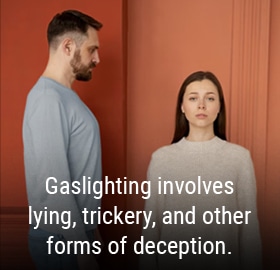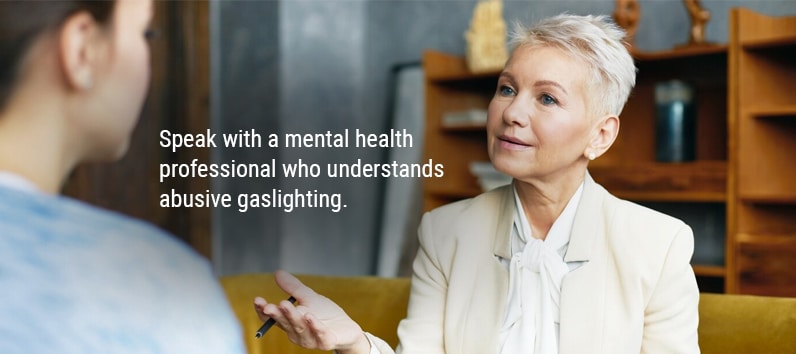Most of us are now familiar with the term “Gaslighting”, which is used loosely in response to many situations within diverse relationship types. Gaslighting isn’t always abusive but when it is, it’s exceedingly difficult to spot. It is known as a “hidden” or covert form of emotional abuse.
It’s essential to your mental and physical well-being to learn how to uncover this hidden form of abuse. So read along as we:
- Define gaslighting
- Look at the power dynamics involved in abusive relationships where gaslighting takes place
- Share 10 signs you are being gaslighted
- Give some ideas of how you can respond once you know you’re being gaslit.
Let’s get started.
What Is Gaslighting and How Does It Happen
The word gaslighting originated from a 1938 play called “Gas Light.” In this famous play later made into a popular film, the husband mentally and emotionally manipulated his wife into believing she was crazy by secretly changing the intensity of the gas lights in their home. Through secret acts, partial and complete lies, he convinced his wife that she was losing her mind. While she struggled to resolve her confusion, he acted as if he had no idea what she was talking about and feigned genuine concern about her mental well-being. Over time, she also believed she was mentally unwell.
Gaslighting is Abuse
Gaslighting is one of the most common forms of domestic abuse and psychological manipulation by which the abuser attempts to make the victim question their own perceptions, mental health, or well-being and causes significant self-doubt and confusion within the victim. Narcissistic gaslighting is one of the more severe forms of abuse.
Gaslighting involves the abuser playing mind games with the victim through lying, trickery, and other forms of deception designed to make the victim question their own reality and even sanity. By promoting a false narrative, the abuser convinces their partner that they are remembering things wrong or misinterpreting events, which leads the victim to adopt the abuser’s reality, impressions, thoughts, and feelings over their own.
It’s important to note that the abuser intentionally uses gaslighting to mask their faults and increase the victim’s dependence on the abuser. This means the victim doubts their own perspective and becomes more reliant on the abuser to clarify what really took place. There is nothing accidental about abusive gaslighting—especially in a relationship.

Gaslighting in Marriage and Intimate Relationships
Gaslighting in an intimate relationship of any kind is specifically designed to make the target dependent on their abuser due to their inability to make sense of what is truly taking place. Gaslighting takes the victim’s concern off of their partner’s behavior and places it on themself. Abusive gaslighting behaviors may also take place in other personal relationships, such as between friends and co-workers. Workplace gaslighting can be particularly confusing and challenging to address.
The Manipulative Dynamics of Gaslighting
Abusive gaslighting is a form of cognitive manipulation designed to change the thinking and behavioral patterns of the other individual. In interpersonal relationships, the gaslighter will gain power over their partner through covert tactics designed to create seeds of doubt in the victim’s mind. With abusive gaslighting, you will be able to identify a pattern, or consistency, of gaslighting behavior.
This form of abuse becomes most effective when the victim is already showing increased dependence on their partner or when they tend strictly to avoid conflict so they will not be rejected or attacked. The abuser uses this so the victim will feel like they can’t leave. The cycle of abuse in any type of abusive partnership includes a stage of devaluing which makes the victim especially susceptible to the harmful impacts of gaslighting.
Those subjected to gaslighting often experience:
- Loss of Self-Identity: Gaslighting can distort one’s self-image and self-confidence, leading to a loss of identity.
- Constant Self-Doubt: Victims often second-guess themselves and question their own judgments and memory.
- Feeling of Invalidation: The gaslighter often dismisses the victim’s feelings, making them feel invaluable and unseen.
- Isolation: The victims may feel disconnected from others and struggle with establishing trusting relationships.
- Increased Anxiety and Depression: Chronic gaslighting can lead to mental health issues like anxiety and depression.
- A compromised immune system leading to physical illnesses: Prolonged periods of time where stress hormones are repeatedly spiked reeks havoc on your mind and endocrine system.
So, how can you be sure you’re being gaslighted when it’s such a subtle form of abuse? Read on and we’ll help you answer this question.
10 Clear Signs You’re Being Gaslighted
Study these ten gaslighting tactics and consider whether you experience gaslighting in your relationship. If you notice one or more of these signs of gaslighting happening regularly or in a pattern, you are being gaslit.
1. Denying Past Events
One common tactic of gaslighting is when the abuser denies past conversations and events that have actually occurred.
For example, say you confront them on something hurtful they said to you. They may respond by saying, “That never happened” or “You’re making things up.” Although you would swear it really happened the way you remember, the gaslighter’s confident refusal plants seeds of self-doubt and confusion in you. You may wonder if you are forgetting things.
Eventually, this tactic can erode the victim’s confidence and effectively cause them to question their own memory and perception of reality. This is why so many victims journal or record what took place during arguments so they can prove to themselves what the truth actually is.
In fact:
Many experts agree that a telltale sign of how you know you are being gaslighted: if you have an almost uncontrollable need to record a conversation because you want to play it back for the person (or yourself) to make sure you heard it right, it is likely you are being gaslighted. Their false accusations become so convincing that you begin to wonder whether your memory is accurate and so you record conversations. Often, this is with the false hope that the recording will help to resolve the conflict when, it’s unlikely the abuser will give in to your version of events even when you have a recording meant to prove it.
What Happens When You Play the Recording Back?
Instead of the recording convincing the gaslighter that the victim’s memory is accurate, their reaction is another telltale sign you’re dealing with a gaslighter. When you play the recording back to them, you will likely witness them become extremely angry, even raging, because you are calling them out on their behavior and they do not like it.
Next, the gaslighter will likely use the fact that you recorded them to gaslight you further by saying, “See, I told you you were crazy! That you would actually record your own spouse, you’re nuts!” Let this convince you that you’re dealing with gaslighting.
2. Invalidating Feelings and Experiences
Gaslighters often invalidate the feelings and experiences of their victims. They may say things like, “You’re overreacting” or “You’re too sensitive.” By responding this way, they effectively dismiss and belittle the victim’s emotions. This undermines the victim’s sense of self and makes them doubt the validity of their own feelings too.
For instance, in a family setting, a gaslighter might respond to a child’s fears or anxieties by telling them they are irrational. This causes the child to question their own emotions and feel guilty for expressing them. This invalidation of feelings can lead to a loss of self-confidence and a heightened reliance on the gaslighter’s interpretation of reality.

3. Shifting Blame
Gaslighters frequently shift blame onto their victims as a way to avoid taking responsibility for their actions. They may say things like, “You’re the one causing all the problems” or “You’re the reason I acted that way.” By doing this, the gaslighter manipulates the victim into believing that they are at fault for the abuser’s behavior. The victim’s self-blame protects the abuser’s image and makes the victim feel more dependent on them.
In a work environment, for example, a gaslighter may blame a colleague for their own mistakes or shortcomings, making the victim question their competence and contribution to the team. This can lead to feelings of guilt and self-doubt, further strengthening the gaslighter’s control over the victim.
4. Creating Doubt
Gaslighters excel at creating doubt in their victims’ minds. They may say things like, “Are you sure you remember that correctly?” or “I think you’re imagining things.” By planting seeds of uncertainty, the gaslighter makes the victim question their perception of reality.
For instance, in a romantic relationship, the gaslighter might constantly challenge the victim’s memory of events, making them doubt their recollection of past conversations or interactions. This constant questioning of reality can lead to a sense of confusion and self-doubt, as the victim starts relying more on the gaslighter’s version of events.
5. Gaslighting Through Manipulative Apologies
Gaslighters often use manipulative apologies to deflect responsibility and avoid accountability. They may say things like, “I’m sorry you feel that way” or “I apologize if you misunderstood me.” Or, they may give you a partial apology or a full apology leading you to believe change is forthcoming but change never occurs.These apologies are not genuine and are intended to make the victim doubt their judgment and emotions. They are implying that the victim is overreacting or being overly sensitive or they are used to stall consequences.
6. Gaslighting Through Projection
Gaslighters often project their flaws and insecurities onto their victims as a way to deflect attention away from themselves. They may say things like, “You’re the one who always causes problems” or “You’re manipulative.” By projecting their negative traits onto the victim, the gaslighter manipulates them into believing that they are the ones at fault.
In a family context, for example, a gaslighting parent might accuse their child of being selfish or irresponsible, when in reality, it is the parent who exhibits those behaviors. This projection can lead to feelings of guilt and self-doubt in the victim, as they internalize the gaslighter’s criticisms and believe that they themselves are inherently flawed.
7. Gaslighting Through Minimization
Gaslighters often minimize the experiences and challenges faced by their victims. They may say things like, “Other people have it worse” or “You’re making a big deal out of nothing.” By downplaying the victim’s emotions and experiences, the gaslighter invalidates their struggles and makes them feel guilty for expressing their needs.
For instance, in a romantic relationship, the gaslighter might dismiss the victim’s concerns about their behavior by comparing it to more extreme examples of abuse. This minimization can lead to the victim questioning the validity of their own emotions and feeling guilty for seeking support or validation.
8. Gaslighting Through Isolation
Gaslighters often isolate their victims from their support networks as a way to maintain control. They may say things like, “Your friends don’t really care about you” or “Your family is just trying to manipulate you.” By undermining the victim’s relationships, the gaslighter creates dependency and makes it harder for the victim to seek help or escape the abusive situation.
In a workplace setting, for example, a gaslighting colleague might try to turn others against a victim by spreading false rumors or gossip. This isolation can lead to a loss of self-esteem, and feelings of loneliness and helplessness, as the victim becomes increasingly reliant on the gaslighter for validation and support.
9. Gaslighting Through Gaslighting
Gaslighters often use gaslighting as a tactic to manipulate their victims. They may say things like, “You’re just imagining things” or “You’re the one who’s gaslighting me.” By flipping the script and accusing the victim of gaslighting, the gaslighter is engaging in pathologizing which further confuses and undermines the victim’s sense of reality.
For instance, in a romantic relationship, the gaslighter might accuse the victim of being manipulative or crazy when confronted about their abusive behavior. This gaslighting through gaslighting can lead to a cycle of self-doubt and internalized blame, as the victim starts questioning their sanity and motives.
10. Gaslighting Through Love and Affection
Gaslighters often use expressions of love and affection as a way to manipulate their victims. They may say things like, “I’m only doing this because I care about you” or “I love you too much to let you make the wrong decisions.” By framing their abusive behavior as acts of love, the gaslighter confuses the victim and makes them question their judgment.
In a romantic relationship, for example, the gaslighter might justify their controlling behavior by feigning concern and compassion for them. For example, they might say, “I’m worried about you.” Or, “Why don’t you see someone to help you with your emotions.” “I love you and want you to get healthy.” The feigned compassion makes the victim feel confused and begin to wonder if their mental health is the problem.

This manipulation can lead to feelings of guilt and self-doubt in the victim, as they struggle to reconcile the gaslighter’s expressions of love with the harm they are experiencing.
If you have noticed one or more of these happening repeatedly in your relationship, you’re probably being gaslit.
So, let’s talk about what you can do about it.
What to Do When Someone Is Gaslighting You
First, let’s consider how often people say things that could sound like gaslighting but aren’t. Think of times you have heard or even said some of the following:
- “That’s not what I said.”
- “That’s not what happened.”
- “You never told me that!”
- “I was only kidding!”
Exhaustion, frustration or sincere confusion, or memory lapse can cause us to respond in unhelpful ways. Saying these things does not mean someone is a gaslighter.
True gaslighters intentionally use tactics to hide their faults and ensure the victim remains dependent upon them and in their control.
If you think you are a victim of abusive gaslighting, here are some things you may want to do:
Keep a Record of Events
Successful gaslighting will make you feel highly confused, unstable, or unsettled. An important step in taking its power away and regaining a firm foundation is by keeping a record of events. Journal or voice record meaningful events when they happen and safeguard these records so your partner cannot find them.
For example, say your partner verbally attacks you in front of your family members or your friends while you are out, write down exactly what they said and anything else that happened. If you confront them later and they deny it or tell you they didn’t say it, remind yourself of the truth by reading your journal entry or listening to your voice recording. This will help you to remain confident in your memories and perceptions.
Create Space
It’s important to get a mental or physical distance from gaslighting so you may regain your sense of self. Learn more about creating space in our blog on the top ways to respond to gaslighting.
Another way to create some mental space is through meditation, prayer, yoga, exercise, etc. Feed your spirit, body, and brain with rest, calm, and spirituality that is separate from the gaslighter’s influence. The key is to regain the right perspective about yourself and your circumstances without interruption from your abuser.
Share with a Trusted Confidant
Even just one friend or family member can make a big difference. Find a small circle of trustworthy individuals to share what is going on. By consistently sharing with the same few people, they are more likely to mirror back what they are hearing, identify patterns they are seeing, and remind you that you are “not crazy.”
Because you are not crazy.
Talk To A Professional For Support And Advice
 Gaslighting is a serious form of emotional abuse that can have long-lasting effects on a person’s mental and emotional well-being.
Gaslighting is a serious form of emotional abuse that can have long-lasting effects on a person’s mental and emotional well-being.
If you believe you are a victim of gaslighting, it may be time to seek professional help. If you aren’t sure where to go, we encourage you to contact the National Domestic Violence Hotline (800.799.SAFE (7233). They will be able to help you locate appropriate services in your area.
You deserve to speak with a mental health professional who understands abusive gaslighting and can help guide you toward clarity and healing. Finding a trained expert who is skilled in working with victims of gaslighting is a critical step toward protecting your mental health and overall healing. When shopping for a therapist, ask specific questions about their training and experience in working with people in emotionally abusive relationships. Not every therapist is trained in emotional abuse. It’s up to you to interview therapists the same way you would interview a childcare professional for your little one.
Remember, you are worthy of being treated with respect and empathy in all your relationships.







